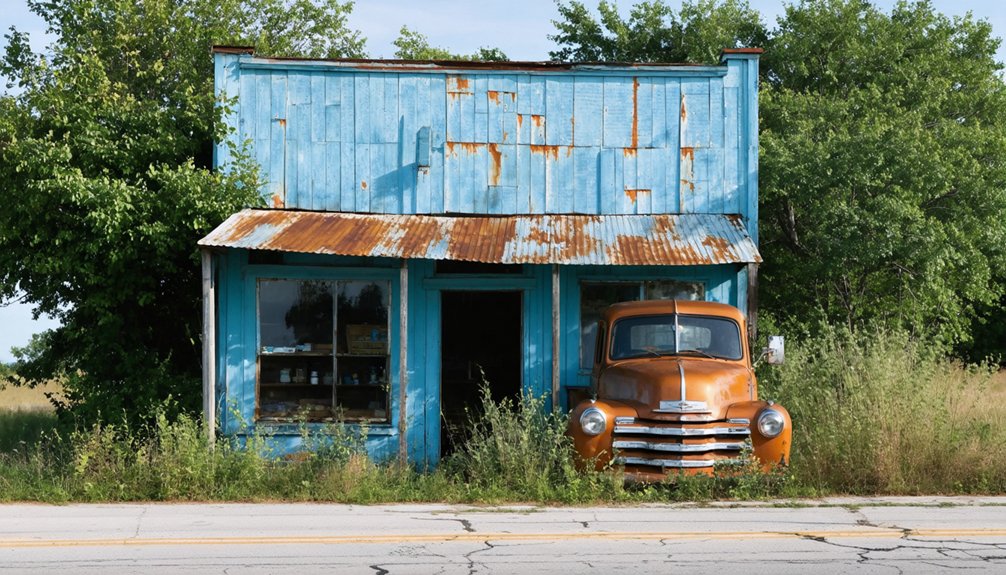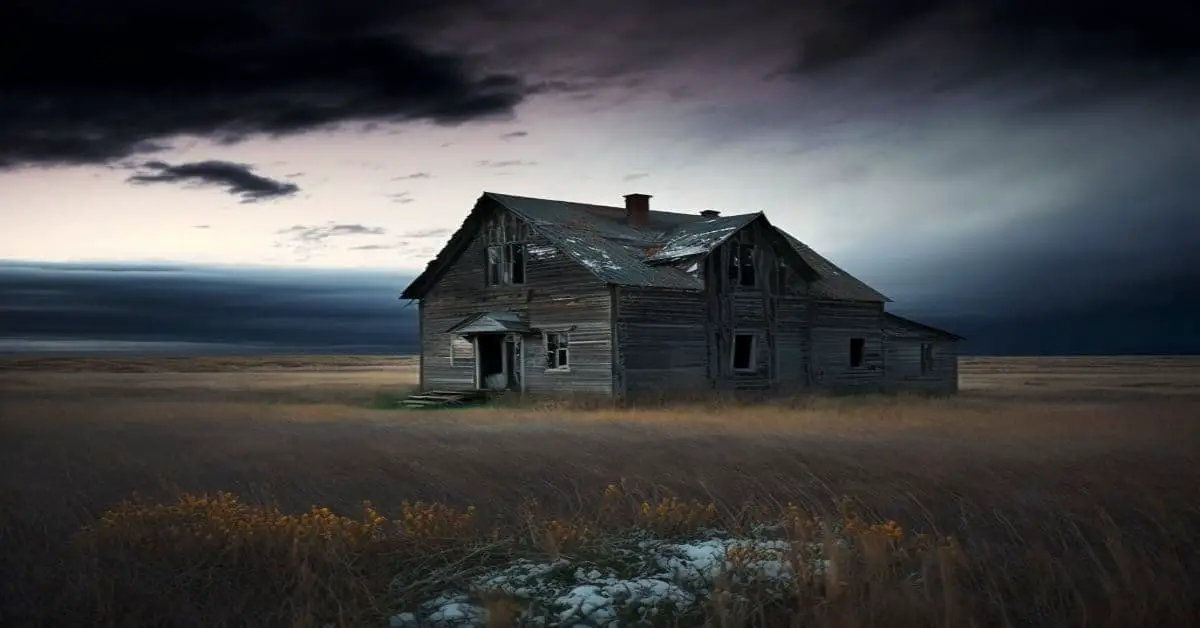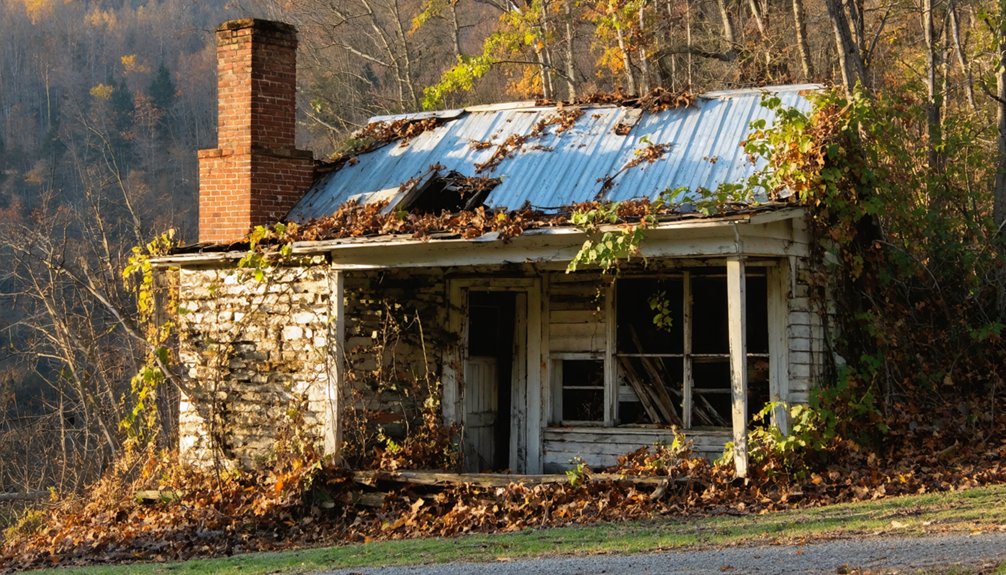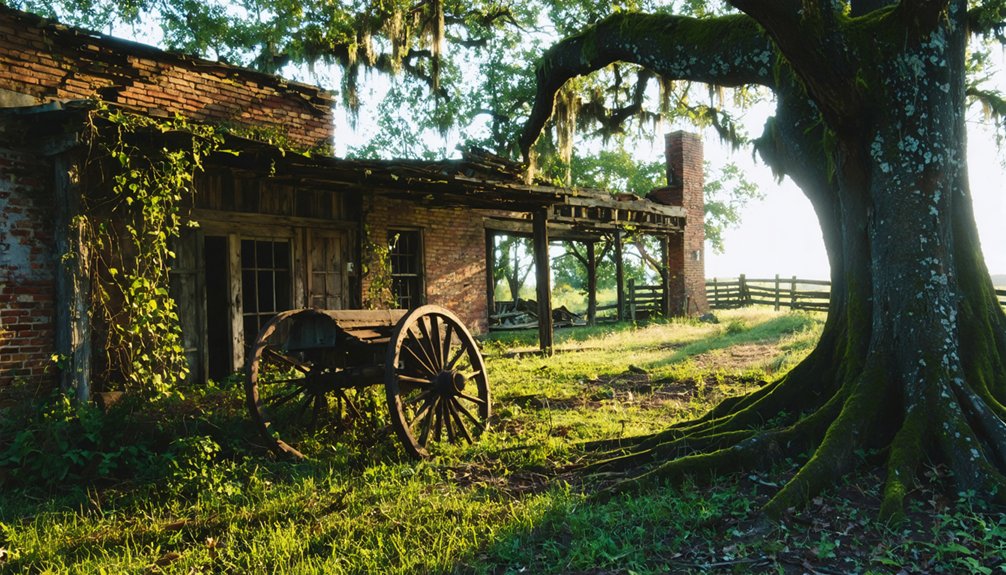You’ll discover Eros nestled in Marion County, Arkansas – a ghost town that began as a Christian utopian settlement in 1854. The community thrived through the 1930s when its iconic WPA-funded school was built, now listed on the National Register of Historic Places. Today, weathered structures like the dilapidated general store and historic cemetery tell stories of ambitious spiritual pioneers who once called this Ozark Mountain haven home. The site’s abandoned buildings hold secrets of a fascinating communal experiment.
Key Takeaways
- Eros was established in 1854 as a Christian communal settlement in Marion County, Arkansas, focused on spiritual unity and collective living.
- The community reached its peak in the 1930s with the WPA-funded Eros School Building, now listed on the National Register.
- Economic pressures, industrialization, and changing demographics led to the settlement’s eventual abandonment and ghost town status.
- Historic structures include the old school building, cemetery with early settler graves, and ruins of the general store.
- The community once thrived through agricultural cooperation, with the general store serving as both supply center and social hub.
The Rise and Fall of a Christian Utopian Settlement
While many utopian communities emerged across 19th-century America, Eros, Arkansas carved out its unique vision of Christian communal life when white settlers first established it in 1854.
Guided by utopian ideals, they created a settlement where spiritual unity and collective sustainability formed the cornerstones of daily life. Early religious services in the area were often conducted in local schoolhouses, following the common practice of Marion County settlers.
Founded on dreams of paradise, Eros embodied a vision where faith and shared purpose illuminated the path toward communal harmony.
You’ll find that Eros flourished through the late 1800s, establishing a post office and township schools that strengthened community cohesion. During this period, Prairie Township maintained five separate schools to serve its growing population.
The settlement’s Christian principles shaped everything from governance to education, reaching its peak in the 1930s when the Works Progress Administration funded the construction of the Eros School Building.
However, like many utopian experiments, Eros couldn’t sustain its vision indefinitely.
Economic pressures, changing demographics, and industrialization eventually led to its decline and abandonment, leaving behind only memories of its ambitious spiritual experiment.
Historic Landmarks and Abandoned Structures
Today, the physical remnants of Eros’s utopian past stand as silent witnesses to its former glory.
You’ll find the old school building, listed on the National Register of Historic Places, as the best-preserved example of historic architecture in the area. Its weathered stone walls contrast sharply with the dilapidated general store nearby, where broken windows and deteriorating wooden framework showcase the effects of rural decay.
The local cemetery, with its weathered limestone and marble gravestones, offers glimpses into the lives of early settlers. While most structures have succumbed to nature’s reclamation, these remaining landmarks create a haunting tableau just west of Yellville. The area was once a thriving farming community that supported numerous families through agricultural endeavors.
The Daily Lumber Company once operated a major sawmill operation here, providing jobs and economic stability to the region.
The site’s proximity to Bull Shoals Lake and accessibility via country roads makes it an ideal stop for those seeking traces of Arkansas’s agricultural past.
Life in the Ozark Mountain Community
Life in 1854 Eros began with the arrival of resilient pioneers who carved their existence from the rugged Ozark terrain. You’d have found these settlers bringing their essential tools, livestock, and cherished heirlooms by ox-drawn wagon, ready to master the challenges of mountain living.
Community agriculture defined daily life, as you’d witness neighbors helping neighbors clear land, tend crops, and preserve food for winter months. The general store served as your lifeline for supplies and social connection, while the school building became the heart of rural traditions. Families often settled near kinfolk for support during tough times. The community flourished amid the dense forest landscape that characterized the region.
Inside its Craftsman-style walls, you’d gather for stage events and community meetings. European-American settlers and African Americans worked the land together, sharing agricultural knowledge and survival skills, creating a tight-knit community where self-sufficiency wasn’t just valued – it was essential.
Exploring the Hidden Ghost Town Today
Hidden among the rolling Ozark Mountains, Eros stands frozen in time, its weathered buildings and overgrown paths beckoning curious explorers.
The Christian utopian settlers established this community with dreams of building a perfect society. You’ll discover the haunting remains of what was once a thriving utopian community, just 30 miles south of Bull Shoals Lake. The partially restored schoolhouse, now listed on the National Register of Historic Places, serves as a centerpiece for ghostly encounters and historical reflection.
Like many weekend road trips through Arkansas’s ghost towns, this destination offers a compelling glimpse into the past. As you wander through the free-to-visit site, you’ll find the crumbling general store and weather-worn cemetery, perfect spots for nature exploration and connecting with Arkansas’s past.
The surrounding Ozark landscape provides an ideal backdrop for sketching, journaling, or simply soaking in the eerie atmosphere.
Plan about 30 minutes to explore this representation of rural America’s ever-changing landscape.
Preservation Efforts and Historical Legacy
Standing as a tribute to rural Arkansas’s heritage, the Eros School Building anchors preservation efforts in this ghost town through its 1992 listing on the National Register of Historic Places.
Its Craftsman-style details and fieldstone sheathing showcase the Works Progress Administration‘s influence during the Great Depression.
You’ll discover the town’s historical significance through:
- The partially restored school building, featuring original architectural elements and an interior stage that speaks to community gatherings of the past.
- A weathered cemetery that tells the stories of early settlers through its preserved gravestones.
- The ruins of the general store, where artifacts visible through broken windows offer glimpses into daily life from decades past.
While community engagement remains limited, the nearby Ozark Mountain School District helps maintain awareness of this important piece of Marion County’s rural legacy. Like many towns in the region, Eros faced economic hardship when zinc mining operations declined after World War I.
Similar to other Arkansas ghost towns, Eros retains few physical remnants of its once-thriving community.
Frequently Asked Questions
Are There Any Reported Ghost Sightings or Paranormal Activities in Eros?
You won’t find documented ghostly legends or paranormal investigations here. Despite its eerie forest setting and abandoned structures, there’s no credible evidence of supernatural activity in this former utopian community.
What Is the Best Time of Year to Visit Eros?
With temperatures hovering around 70°F, you’ll find fall (late September to November) offers the best weather conditions for exploring. Colorful foliage peaks in early November, making ruins more visible and hiking more comfortable.
How Safe Is It to Explore the Abandoned Structures?
You’ll need to take serious safety precautions – many structures have compromised structural integrity. Don’t enter the ruined general store, and stay alert for unstable walls and falling debris when exploring.
Can Visitors Take Artifacts or Souvenirs From the Site?
Like precious jewels in time’s vault, you’re legally bound to leave artifacts untouched. Souvenir regulations and preservation laws strictly prohibit removing any items from the site – take only photos, leave only footprints.
Are There Guided Tours or Local Historians Available for Visits?
You won’t find regular guided tours, but you’re free to explore independently. While local historians occasionally share legends during informal visits, most exploration happens through self-guided discovery of the historic structures.
References
- https://arkansasfrontier.com/ghost-towns-in-arkansas/303766/
- https://www.thetravel.com/ghost-towns-in-arkansas/
- https://jacksonparishjournal.com/2021/08/29/eros-the-town-that-was/
- https://www.onlyinyourstate.com/experiences/arkansas/ar-ghost-towns
- https://encyclopediaofarkansas.net/entries/marion-county-789/
- https://www.youtube.com/watch?v=3oZuUMZk_Eo
- https://en.wikipedia.org/wiki/List_of_ghost_towns_in_Arkansas
- https://www.argenweb.net/marion/stories/marion-co-ar-wr-jones.html
- https://encyclopediaofarkansas.net/entries/eros-school-building-14514/
- https://ect.humspace.ucla.edu/wp-content/uploads/2025/04/Marcuse-Eros-and-Civilization-pp.-9-95.pdf



